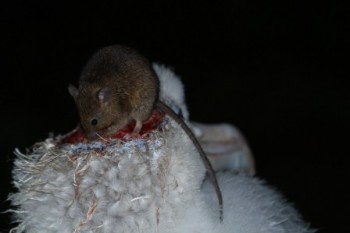Guy Preston (Department of Environmental Affairs, Cape Town, South Africa) and (many!) colleagues have published in the proceedings of an international island invasives conference held in 2017 in Dundee, Scotland on South Africa’s intention to rid its sub-Antarctic Marion Island of House Mice Mus musculus. The mice have turned to attacking seabirds, including ACAP-listed albatrosses (click here). Fund raising has commenced towards an eradication attempt planned for 2021.
The paper’s abstract follows:
“House mice (Mus musculus) were introduced to South Africa’s sub-Antarctic Marion Island, the larger of the two Prince Edward Islands, by sealers in the early 19th century. Over the last two centuries they have greatly reduced the abundance of native invertebrates. Domestic cats (Felis catus) taken to the island in 1948 to control mice at the South African weather station soon turned feral, killing large numbers of breeding seabirds. An eradication programme finally removed cats from the island by 1991, in what is still the largest island area cleared of cats at 290 km². Removal of the cats, coupled with the warmer and drier climate on the island over the last half century, has seen increasing densities of mice accumulating each summer. As resources run out in late summer, the mice seek alternative food sources. Marion is home to globally important seabird populations and since the early 2000s mice have resorted to attacking seabird chicks. Since 2015 c. 5% of summer-breeding albatross fledglings have been killed each year, as well as some winter-breeding petrel and albatross chicks. As a Special Nature Reserve, the Prince Edward Islands are afforded the highest degree of protection under South African environmental legislation. A recent feasibility plan suggests that mice can be eradicated using aerial baiting. The South African Department of Environmental Affairs is planning to mount an eradication attempt in the winter of 2021, following a partnership with the Royal Society for the Protection of Birds to eradicate mice on Gough Island in the winter of 2020. The eradication programme on Marion Island will be spearheaded by the South African Working for Water programme – Africa’s biggest conservation programme focusing on the control of invasive species –which is already driving eradication projects against nine other invasive species on Marion Island.”

Scalped! A House Mouse feeds on the head of a downy Wandering Abatross Diomedea exulans chick at night on Marion Island
Photograph by Stefan Schoombie
Reference:
Preston, G.R., B.J. Dilley, J. Cooper, J. Beaumont, L.F. Chauke, S. L. Chown, N. Devanunthan, M. Dopolo, L. Fikizolo, J. Heine, S. Henderson, C.A. Jacobs, F. Johnson, J. Kelly, A.B. Makhado, C. Marais, J. Maroga, M. Mayekiso, G. McClelland, J. Mphepya, D. Muir, N. Ngcaba, N. Ngcobo, J.P. Parkes, F. Paulsen, S. Schoombie, K. Springer, C. Stringer, H. Valentine, R.M. Wanless & P.G. Ryan 2019. South Africa works towards eradicating introduced house mice from sub-Antarctic Marion Island: the largest island yet attempted for mice. pp. 40-46. In: Veitch, C.R., Clout, M.N., Martin, A.R., Russell, J.C. & West, C.J. (Eds). Island Invasives: Scaling up to meet the Challenge. Gland, Switzerland: IUCN. xiv + 734 pp.
John Cooper, ACAP Information Officer, 27 March 2019

 English
English  Français
Français  Español
Español